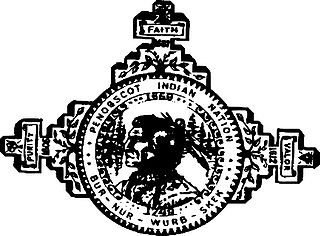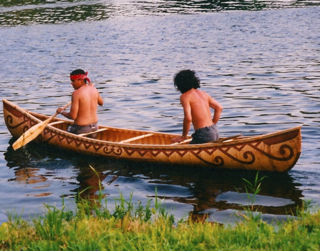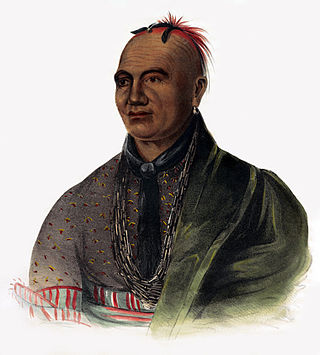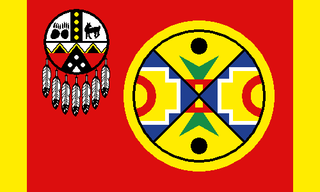
The Abenaki are Indigenous people of the Northeastern Woodlands of Canada and the United States. They are an Algonquian-speaking people and part of the Wabanaki Confederacy. The Eastern Abenaki language was predominantly spoken in Maine, while the Western Abenaki language was spoken in Quebec, Vermont, and New Hampshire.

Aroostook County is a county in the U.S. state of Maine along the Canada–United States border. As of the 2020 census, the population was 67,105. The county seat is Houlton, with offices in Caribou and Fort Kent.

Penobscot Indian Island Reservation is an Indian reservation for the Penobscot Tribe of Maine, a federally recognized tribe of the Penobscot in Penobscot County, Maine, United States, near Old Town. The population was 758 at the 2020 census. The reservation extends for many miles alongside 15 towns and two unorganized territories in a thin string along the Penobscot River, from its base at Indian Island, near Old Town and Milford, northward to the vicinity of East Millinocket, almost entirely in Penobscot County. A small, uninhabited part of the reservation used as a game preserve and hunting and gathering ground is in South Aroostook, Aroostook County, by which it passes along its way northward.

Houlton is a town and county seat of Aroostook County, Maine, United States, on the Canada–United States border. As of the 2020 census, the town's population was 6,055. It is perhaps best known for being at the northern terminus of Interstate 95 and as the birthplace of Samantha Smith, a goodwill ambassador as a child during the Cold War. The town hosts the annual Houlton Agricultural Fair.

The Penobscot are an Indigenous people in North America from the Northeastern Woodlands region. They are organized as a federally recognized tribe in Maine and as a First Nations band government in the Atlantic provinces and Quebec.

The Passamaquoddy are a Native American/First Nations people who live in northeastern North America. Their traditional homeland, Peskotomuhkatikuk, straddles the Canadian province of New Brunswick and the U.S. state of Maine in a region called Dawnland. They are one of the constituent nations of the Wabanaki Confederacy.
The Wolastoqiyik, also Wəlastəkwewiyik, Malecite or Maliseet are an Algonquian-speaking First Nation of the Wabanaki Confederacy. They are the Indigenous people of the Wolastoq valley and its tributaries. Their territory extends across the current borders of New Brunswick and Quebec in Canada, and parts of Maine in the United States.

The Maine House of Representatives is the lower house of the Maine Legislature. The House consists of 151 voting members and three nonvoting members. The voting members represent an equal number of districts across the state and are elected via plurality voting. The nonvoting members represent three of Maine's Native American tribes, though two tribes have declined to send representatives. Each voting member of the House represents around 9,000 citizens of the state. Because it is a part-time position, members of the Maine House of Representatives usually have outside employment as well. Members are limited to four consecutive terms of two years each, but may run again after two years.

Indigenous peoples of the Northeastern Woodlands include Native American tribes and First Nation bands residing in or originating from a cultural area encompassing the northeastern and Midwest United States and southeastern Canada. It is part of a broader grouping known as the Eastern Woodlands. The Northeastern Woodlands is divided into three major areas: the Coastal, Saint Lawrence Lowlands, and Great Lakes-Riverine zones.

Harald E. L. Prins is a Dutch anthropologist, ethnohistorian, filmmaker, and human rights activist specialized in North and South America's indigenous peoples and cultures.

Abenaki, also known as Wôbanakiak, is an endangered Eastern Algonquian language of Quebec and the northern states of New England. The language has Eastern and Western forms which differ in vocabulary and phonology and are sometimes considered distinct languages.

Joint Tribal Council of the Passamaquoddy Tribe v. Morton, 528 F.2d 370, was a landmark decision regarding aboriginal title in the United States. The United States Court of Appeals for the First Circuit held that the Nonintercourse Act applied to the Passamaquoddy and Penobscot, non-federally-recognized Indian tribes, and established a trust relationship between those tribes and the federal government that the State of Maine could not terminate.
David Slagger is a Native American politician in Maine. Slagger served as a member of the Maine House of Representatives, representing the newly recognized Maliseet Tribe. Slagger was sworn-in as the appointed representative to the House of Representatives on January 4, 2012. He held the seat temporarily until a tribal election could be conducted to elect a Maliseet Tribal Representative, which the Maliseet Tribe then did on December 22, 2012 when tribal members elected Henry John Bear as their first elected Tribal Representative to the Maine House of Representatives. Slagger did not seek another term as Maliseet representative.

The Mi'kmaq Nation is a US federally recognized tribe of Mi'kmaq people, based in Aroostook County, Maine. Their autonym is Ulustuk. Of the 28 bands of Mi'kmaq people, the Mi'kmaq Nation is the only one in the United States. The Mi'kmaq Nation were the first non-US power to sign a treaty with the United States, the Treaty of Watertown, on 6 July 1776.

The Houlton Band of Maliseet Indians of Maine (HBMI) is a federally recognized tribe of Maliseet, whose land is along the Meduxnekeag River in Maine, United States. They are headquartered in Littleton, Maine, located in Aroostook County.
The Maine Indian Newsletter was a monthly newsletter published independently from 1966 to 1972 in Gardiner, Maine and Freeport, Maine. While the exact address is not listed, the office was on Pine Street in Freeport. All of the articles archived by Dawnland Voices have Pine Street listed as the place to send submissions and money.
Rena D. Newell was the Passamaquoddy tribal representative to the Maine House of Representatives during the 129th and 130th legislatures. During her two terms, she was the only tribal representative in the Maine House.